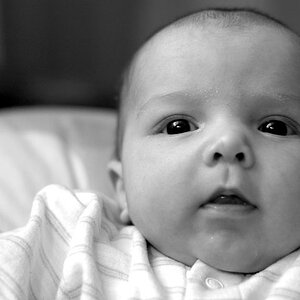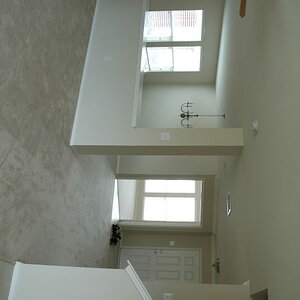shuttercraft
TPF Noob!
- Joined
- Jan 12, 2009
- Messages
- 57
- Reaction score
- 0
- Location
- Grants Pass Oregon
- Website
- mwilbourn.com
- Can others edit my Photos
- Photos NOT OK to edit
Many people want to take photography to the next level, but are scared away by the tremendous amount of money it takes just to obtain entry level equipment! Most people cant afford a $2000 camera or a $1000 lighting system. Some people let there dreams of pursuing photography as a major hobby or job fade away. lack of money should never kill your dreams! I found ways to produce amazing photography on a budget. You do not need the best lights, or the best camera on the market. Sure, there are many pros to having pro equipment. The truth is you do not need pro equipment to produce pro media. This guide will show you how to get into photography on a budget , without limiting want you can produce.
In this section you will learn what to look for when buying a camera.

I know this is suppose to be a Cheep Photography Guide, you can get by with a cheep $150 fixed lens camera, but If you can fork out $500 for a SLR (single reflex lens) camera you will be glad you did in a year. The camera seen above is the newer Canon Rebel Xsi/450d. This is a great SLR camera to get started with if you can afford it. This and the canon 40D is what I use today. The 40D is a lower class SLR camera that has the features of a $4,000 pro SLR. If photography is just a hobby to you then you should buy a cheaper fixed lens camera. You can get a fixed lens, or point and shoot camera for as cheep as $100-$200. If you want to pursue photography as a serous hobby or even as a job, then I highly suggest getting one of the entry level SLRs from Canon, Sony, Pentax, olympus or Nikon. The reason you should get a SLR (single reflex lens) is because you can buy multiple interchangeable lens for different situations. The possibilitys of a SLR will grow as you become more and more familiar with it. If you buy a fixed lens camera you will hit limitations as you skills grow, Not to say you cant get good pictures off of a point and shoot camera, you just will hit limitations that you will not have to worry about in a SLR type camera.
Some thing to think about when buying a camera are:
- Price Range
- Lens
- Required Media (disks, cards)
- Batteries
- Flash
- Weight/Size
- Extra Features
- Durability/Build
Point and shoot cameras sell or fixed lens type cameras for $200 - $500. Entry level SlR type cameras sell for 500 - $2,000, the big dogs can go for as much as $3,000 to $20,000. You can get a $600-$800 SLR with pro capabilities.
LensYou need to buy a lens that will fit your needs. you need different lenses for different situations. If you are doing family portraits, Landscape, architecture, and anything els that calls for a wide angles, go for a 18-55mm lens this will go good for general photography. if you are plan to be shooting birds, personal portraits, and anything els close up get a telephoto zoom lens. (50mm-200mm) is a good start. There are lenses that cover from 18mm to 200mm but good quality ones are not cheep. Back in the day everyone worked with film cameras. Then you could buy a cheep Camera body and a nice lens and you would have a pro setup. the body did not matter much because all it had to do was expose the film. The lens was the important part of the camera. In the digital age of today the camera body is as important as the lens.
Required MediaCompact Flash and SD cards are most commonly used in toadys market. Some older cameras use disks, some even have a built in hard drive. I would not recommend a camera that has a built in hard drive due to the fact that you will be limited to the space of that hard drive. I like SD cards because they are smaller and they hold more. Some people say compact flash cards are better quality but I have never seen any difference between the two in quality.
Batteries
Most point and shot cameras today run off of AA and AAA batteries. Most SLRs tend to use L-ion Batteries.
AA-AAA pros
- Cheep
- Easy to get in most locations
- Compact
AA-AAA Cons
- Short life
- unreliable
- limited recharge cycles
L-ion Batteries pros
- Long life
- Many recharge cycles
- Reliable
L-ion Batteries cons
- Bad performances in cold conditions
- bulky

The built in flashes on most cameras are not to good because they are vary limited. If you have a SLR camera that you can change the stings of the built in flash then it will do. On camera shoe mount flashes are great! This kind of flash fits in the hot shoe of a SLR camera, yet another reason to buy a SLR. Most all SLRs come with a flash mount called a hot shoe on top of the camera. Some SLRs come with a PC port to control off camera flashes. This kind of flash can be vary expensive ($100-$300), but you can do a lot with one flash. later in the guide you will learn about cheaper lighting solutions.
Extra FeaturesSome extra things to look for when buying a camera are:
- Image Stabilization
- Continuous Shooting
- Rain/Weather Protection
- RAW Shooting Capability
- PC Port
- Flash Shoe Mount
- Timer etc.
_________________________________________
Cheap Lighting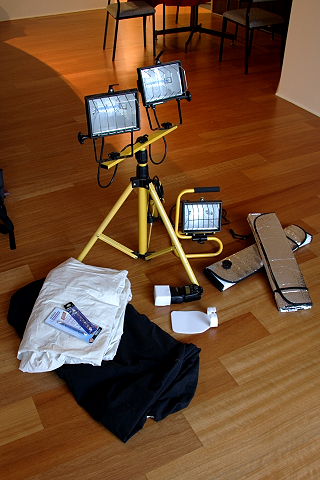
Today we are pumped full of crap through are media, they tell us stuff like you have to buy the best to be the best. Dont let the lies of advertising take hold of you. You can produce amazing work on a limited budget. Sure, pro lights have many great things going for them. If you have that kind of money then you should not be reading this. Lighting can get expensive, people end up spending more on lighting then there cameras in some cases. The horrifying costs of lighting can scare many people away from the art of photography. If you are just starting out on a limited budget then $1000 lights are out of the question. You will be glad to hear that you can produce amazing work with a limited light setup.
So, how do you do it?
There are many other alternatives to pro lighting, here are a few.:
There are many other alternatives to pro lighting, here are a few.:
- Work Lights
- Clamp lights
Work lights are great for all around lighting situations, they are cheep and bright. Some photographers use work lights alone, like photographer Jesse Crouch he uses work lights for all situations, below is a photo from him. There is a few bad things about work lights, they get vary hot and they are nonadjustable in most situations.
This portrait is completely lit by work lights.

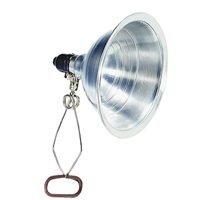
Clamp lights are good in many situations, because they can clamp to just about anything. Most clamp lights come with a reflective cone. This will help out when you want to focus the light in one general direction. I like them a lot because I end up saving money on stands, but Im cheep. Just like work lights these are unadjustable, the amount of heat they produce depends on the type of bulb you buy.
Reflectors/diffusersReflectors:

Reflectors are not that expensive, and they are vary helpful. If you dont want to buy one then grab a white T-shirt, Car window shade, tin foil, you get the idea.
Diffuser:
A diffusion panel is used to diffuse or soften studio light or natural light that is falling onto your subject. Generally, diffusion panels are constructed as a metal or plastic frame covered with semi-transparent material which allows light to pass through it. The light hits the panel and becomes smooth and soft, creating a gentle light that wraps around contoured surfaces and creates a gradual fall off. Diffusion panels come in many sizes and are often used as the only light modifier between the subject and the key light.
POST EDITING
Photoshop

Yes, you will need to spend some real cash to get Photoshop. You can get by with other cheaper or free graphic editing programs out there, like Photoshop Elements, Lightroom, Gimp (free), ect. I do recommend buying Photoshop if you can find a way to fit it into your budget.
Possibilitys are endless with the power of Photoshop, with a great editing program you can produce amazing images at any budget. I know that I may sound like I work for Adobe, but the truth is Photoshop gives photographers so many more creative abilitys.
The GIMP
GIMP is an acronym for GNU Image Manipulation Program. It is a freely distributed program for such tasks as photo retouching, image composition and image authoring.
It has many capabilities. It can be used as a simple paint program, an expert quality photo retouching program, an online batch processing system, a mass production image renderer, an image format converter, etc.
GIMP is expandable and extensible. It is designed to be augmented with plug-ins and extensions to do just about anything. The advanced scripting interface allows everything from the simplest task to the most complex image manipulation procedures to be easily scripted.
GIMP is written and developed under X11 on UNIX platforms. But basically the same code also runs on MS Windows and Mac OS X. Gimp does have some problems and glitches, but who can complain its FREE! I do not use gimp simply because I already have Photoshop. I recommend looking into Gimp if you cannot buy Photoshop.
Last edited:



![[No title]](/data/xfmg/thumbnail/40/40310-01bec1b9b7918522bf21a09cf75c5266.jpg?1619739414)
![[No title]](/data/xfmg/thumbnail/40/40312-7470c3c8f9e3a40e6b44c423096f188d.jpg?1619739414)
![[No title]](/data/xfmg/thumbnail/40/40311-715dda8167abb793178d6abf7e8136fe.jpg?1619739414)
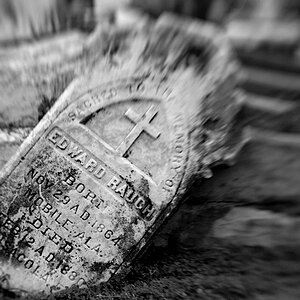
![[No title]](/data/xfmg/thumbnail/39/39442-c7791194bfea1b4d6bd382b004fb8488.jpg?1619739033)
![[No title]](/data/xfmg/thumbnail/33/33343-857a08c1327857172779bfe49f06f638.jpg?1619735911)
